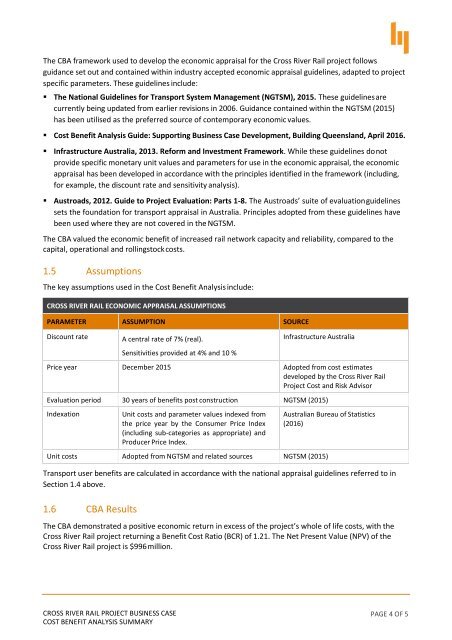CROSS RIVER RAIL PROJECT BUSINESS CASE
Cross-River-Rail-Cost-Benefit-Analysis-Summary
Cross-River-Rail-Cost-Benefit-Analysis-Summary
Create successful ePaper yourself
Turn your PDF publications into a flip-book with our unique Google optimized e-Paper software.
The CBA framework used to develop the economic appraisal for the Cross River Rail project follows<br />
guidance set out and contained within industry accepted economic appraisal guidelines, adapted to project<br />
specific parameters. These guidelines include:<br />
• The National Guidelines for Transport System Management (NGTSM), 2015. These guidelines are<br />
currently being updated from earlier revisions in 2006. Guidance contained within the NGTSM (2015)<br />
has been utilised as the preferred source of contemporary economic values.<br />
• Cost Benefit Analysis Guide: Supporting Business Case Development, Building Queensland, April 2016.<br />
• Infrastructure Australia, 2013. Reform and Investment Framework. While these guidelines do not<br />
provide specific monetary unit values and parameters for use in the economic appraisal, the economic<br />
appraisal has been developed in accordance with the principles identified in the framework (including,<br />
for example, the discount rate and sensitivity analysis).<br />
• Austroads, 2012. Guide to Project Evaluation: Parts 1-8. The Austroads’ suite of evaluation guidelines<br />
sets the foundation for transport appraisal in Australia. Principles adopted from these guidelines have<br />
been used where they are not covered in the NGTSM.<br />
The CBA valued the economic benefit of increased rail network capacity and reliability, compared to the<br />
capital, operational and rollingstock costs.<br />
1.5 Assumptions<br />
The key assumptions used in the Cost Benefit Analysis include:<br />
<strong>CROSS</strong> <strong>RIVER</strong> <strong>RAIL</strong> ECONOMIC APPRAISAL ASSUMPTIONS<br />
PARAMETER ASSUMPTION SOURCE<br />
Discount rate<br />
A central rate of 7% (real).<br />
Sensitivities provided at 4% and 10 %<br />
Infrastructure Australia<br />
Price year December 2015 Adopted from cost estimates<br />
developed by the Cross River Rail<br />
Project Cost and Risk Advisor<br />
Evaluation period 30 years of benefits post construction NGTSM (2015)<br />
Indexation<br />
Unit costs and parameter values indexed from<br />
the price year by the Consumer Price Index<br />
(including sub-categories as appropriate) and<br />
Producer Price Index.<br />
Unit costs Adopted from NGTSM and related sources NGTSM (2015)<br />
Australian Bureau of Statistics<br />
(2016)<br />
Transport user benefits are calculated in accordance with the national appraisal guidelines referred to in<br />
Section 1.4 above.<br />
1.6 CBA Results<br />
The CBA demonstrated a positive economic return in excess of the project’s whole of life costs, with the<br />
Cross River Rail project returning a Benefit Cost Ratio (BCR) of 1.21. The Net Present Value (NPV) of the<br />
Cross River Rail project is $996 million.<br />
<strong>CROSS</strong> <strong>RIVER</strong> <strong>RAIL</strong> <strong>PROJECT</strong> <strong>BUSINESS</strong> <strong>CASE</strong><br />
COST BENEFIT ANALYSIS SUMMARY<br />
PAGE 4 OF 5


